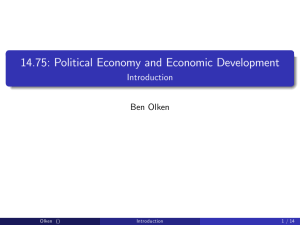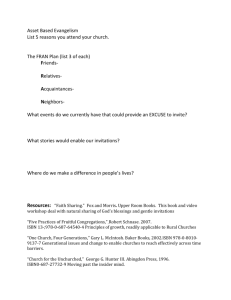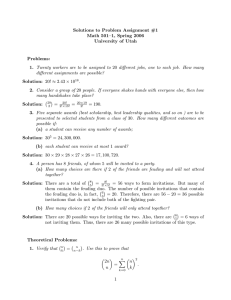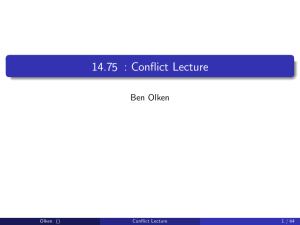Collective Action Lecture 2 14.75: Olken Ben
advertisement
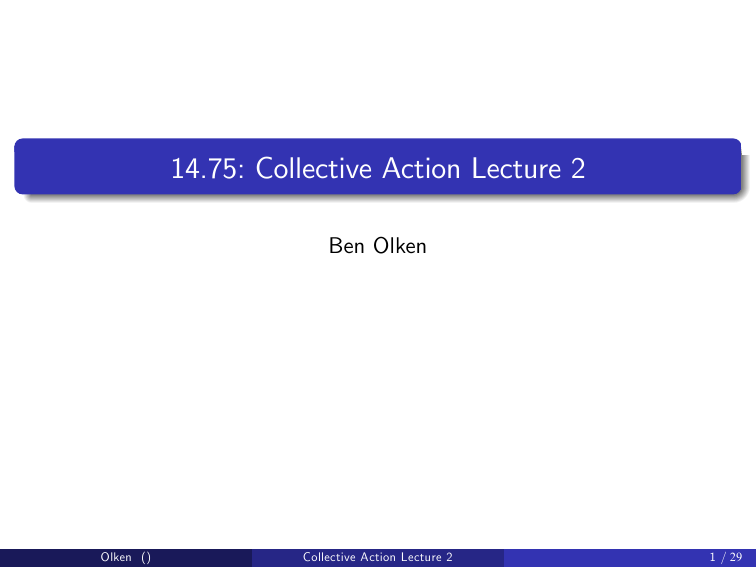
14.75: Collective Action Lecture 2 Ben Olken Olken () Collective Action Lecture 2 1 / 29 Overview Collective action failures stem from misalignment of private and collective incentives (e.g., Olson) In the developing world, one way this manifests itself is insuffi cient monitoring of local offi cials Teachers and health workers not coming to work Local offi cials stealing funds from central government projects (much more to come on these issues in the corruption lectures) So many suggest that a natural solution to this problem is to increase the ability of citizens to monitor local offi cials In fact, this is precisely what the World Bank suggested in the 2004 World Development Report: “Putting poor people at the center of service provision: enabling them to monitor and discipline service providers, amplifying their voice in policymaking, and strengthening the incentives for service providers to serve the poor.” 1 / 29 Olken () Collective Action Lecture 2 2 /29 Overview This lecture: three randomized experiments that sought to increase community-based monitoring of service providers in three different settings — with three very different sets of results Banerjee et al. (2008): education in India — no impact. Björkman and Svensson (2009): health in Uganda — massive impacts. Olken (2007): corruption in road building in Indonesia — impacts only in some circumstances (no free riding, limited elite capture) What’s going on? Olken () Collective Action Lecture 2 3 / 29 Theoretical background Suppose we’re in a world of moral hazard: Bureaucrat can exert effort e ∈ [0, 1] to produce a good, with convex cost of effort 12 ce 2 . Effort is unobservable. Probability public good is produced is e. Each citizen gets utility N1 if good produced, 0 otherwise. Two components of monitoring: One citizen is designated "monitor" The monitor can pay a personal cost 12 αm2 to try to observe whether the public good was not produced. Observe with probability m. If he observes the public good was not produced, he can pay a cost s to share the information with everyone else If he observes that the good was not produced and shares the information with the community, bureaucrat receives punishment p. Timing: Monitor announces monitoring plan m Bureaucrat chooses effort Payoffs realized Olken () Collective Action Lecture 2 4 / 29 Solution Bureaucrat solves 1 max −p (1 − e ) m − ce 2 e 2 so e= Monitor solves max mi i.e. max mi pm c 1 e − αm2 − ms (1 − e ) N 2 pm 1 2 pm − αm − ms 1 − Nc 2 c so the FOC implies m= Olken () p − csN Ncα − 2psN Collective Action Lecture 2 5 / 29 Comparative statics Equilibrium is m = e = p − csN Ncα − 2psN p p − csN c Ncα − 2psN Comparative statics: Reducing the cost of monitoring (α) increases monitoring and effort Reducing the cost of sharing information (s ) increases monitoring and effort Increasing N lowers monitoring and effort (free rider problem) What would happen if bureaucrat could make ex-post side payments to the monitor (elite capture)? Olken () Collective Action Lecture 2 6 / 29 Education in India " of Participatory Banerjee, Banerji, Du‡o, Glennerster, and Khemani (2008): "Pitfalls Programs: Evidence from a Randomized Evaluation in India"" Setting: education in Uttar Pradesh, India Baseline situation: substantial problems with teacher absence and teacher laziness, and 39 percent of children age 7-14 could not read and understand a simple (grade 1 level) story Scope for collective action: each school has a Village Education Committee (VEC) Consists of three parents, the head teacher, and the head of village government Charged with intermediating between village government and bureaucracy, monitoring performance of schools, and controlling some share of the school budget (e.g., community-based teachers, supplemental allowances) But VECs are generally ineffectual: At baseline, most parents did not know the VEC existed Many VEC members did not know their responsibilities Olken () Collective Action Lecture 2 7 / 29 Interventions Treatment 1 (monitoring): Facilitated small group discussions in each hamlet of the village to talk about education Facilitated village-wide meeting to talk about education, providing details about the VEC and the role of it plays. Meeting included villagers, teachers, and village offi cials Facilitators followed up by visiting each VEC member, gave them a pamphlet on VEC roles and responsibilities, and discussed VEC with them Treatment 2 (monitoring + information): Treatment 1 + plus reading report card Villagers taught how to test kids reading levels In each hamlet, villagers tested kids and prepared a report card Olken () Collective Action Lecture 2 8 / 29 Interventions Treatment 3 (monitoring + information + remediation): Treatment 1 + treatment 2 + Village volunteers given 4 trainings in how to teach kids to read Volunteers receive about 7 visits per year from NGO to support the activity What does Treatment 3 test? Why do it? Olken () Collective Action Lecture 2 9 / 29 Experimental Design Experimental design: 280 villages randomly allocated into 4 groups (65 in each treatment and 85 in control): Treatment 1: facilitated discussions Treatment 2: facilitated discussions + village monitoring tool Treatment 3: facilitated discussions + village monitoring tool + village reading tool Are these the right interventions? What else might you have wanted to do? Why more villages in control group? Olken () Collective Action Lecture 2 10 / 29 Multiple outcomes They examine about 70 different outcome variables What’s the problem? What are solutions? Their solution (following Katz, Kling, Liebman 2007): Group indicators into "families" of similar indicators k Regression specification for each family of indicators k: yijk = α + β1k T1 + β2k T2 + β3k T3 + X γk + εijk Compute the average standardized effect 1 K β� tk � βt = � σ k k∑ =1 tk Olken () Collective Action Lecture 2 11 / 29 Results " "First stage": " VEC knew more but did little more ,PDJHVUHPRYHGGXHWRFRS\ULJKWUHVWULFWLRQV6HH%DQHUMHH$EKLMLW5XNPLQL%DQHUMLHWDO3LWIDOOVRI3DUWLFLSDWRU\ 3URJUDPV(YLGHQFHIURPD5DQGRPL]HG(YDOXDWLRQLQ(GXFDWLRQLQ,QGLD1%(5:RUNLQJ3DSHU1R Olken () Collective Action Lecture 2 12 / 29 Health in Uganda Björkman and Svensson 2009: "Power " to the People: Evidence from a Randomized Field Experiment on Community-Based Monitoring in Uganda"" Setting: 50 health centers ("dispensaries") in rural Uganda Each dispensary provides preventive care, outpatient care, maternity, lab services to a population of about 2,500 households Situation is similar to the Indian education context in Banerjee et al. in many ways: Many problems at baseline — stockout rate of 50% of basic drugs, only 41% use any equipment at all during examinations Scope for collective action through Health Unit Management Committee (HUMC), which consists of health workers and non-political representatives of community. Supposed to monitor but does not have hiring/firing power. Very similar to VECs. Olken () Collective Action Lecture 2 13 / 29 Intervention Single intervention with two goals: increasing information about health problems and service delivery failures and strengthening citizen monitoring Specifics of intervention Conduct baseline survey of health problems and quality of services Create facility-specific report card of service delivery, including comparison to other facilities Use community-based organizations to hold facilitated meetings with: Community. Two-day event, including about 150 people. Discussed patient’s rights, how to improve service delivery, etc. Culminated in "action plan" of improvements. Health providers. One-afternoon with all staff. Discussed report card findings. "Interface meeting" of both. Discuss results of two meetings and wrote a "community contract", which included promised changes in service and a plan for community monitoring. Follow-up meeting six months later by community-based organization. How is this comparable to the Indian experiment? How different? Olken () Collective Action Lecture 2 14 / 29 Experimental design 50 dispensaries, randomized into 2 groups of 25 Estimate effects as yijd = α + βTjd + Xjd π + θ d + εijd where X are pre-intervention facility covariates and θ d are district fixed effects For variables with pre-data, they can also estimate yijd = γPOSTt + βDD Tjd ∗ POSTt + µj + εijd How is this different from the Banerjee et al. specification? Olken () Collective Action Lecture 2 15 / 29 Results Results on Service Quality ,PDJHVUHPRYHGGXHWRFRS\ULJKWUHVWULFWLRQV6HH%M|UNPDQ0DUWLQDDQG-DNRE6YHQVVRQ3RZHUWRWKH 3HRSOH(YLGHQFHIURPD5DQGRPL]HG)LHOG([SHULPHQWRQ&RPPXQLW\%DVHG0RQLWRULQJLQ8JDQGD 4XDUWHUO\-RXUQDORI(FRQRPLFVQR 7DEOH,,,3URJUDP,PSDFWRQ7UHDWPHQW3UDFWLFHVDQG0DQDJHPHQW 7DEOH,93URJUDP,PSDFWRQ,PPXQL]DWLRQ 7DEOH93URJUDP,PSDFWRQ8WLOL]DWLRQ&RYHUDJH 7DEOH9,3URJUDP,PSDFWRQ+HDOWK2XWFRPHV Olken () Collective Action Lecture 2 16 / 29 Reconciling with India? How do we reconcile this with the India results? What differences in the treatment might be important? What differences in the setting might be important? Olken () Collective Action Lecture 2 17 / 29 Road Building in Indonesia Olken 2007: "Monitoring " Corruption: Evidence from a Field Experiment in Indonesia"" Setting: 608 villages in rural Indonesia, each of which was building a 1-3km road Roads are built by a 3-person village implementation committee Three village-wide "accountability meetings" where the committee has to account for how they spent the funds, after 40%, 80%, and 100% of funds allocated. Scope for improvement: Like India and Uganda, these meetings do not look very effective: village head typically only invites the elite, and they almost always approve the accountability report Baseline estimates: 25% of funds can’t be accounted for, so potentially pervasive corruption Question: does improving the functioning of these monitoring meetings reduce corruption in the project? Note: the same project also investigated top-down audits: we will discuss more in the corruption lectures Olken () Collective Action Lecture 2 18 / 29 Interventions Invitations Idea: number and composition of people at meeting affects information, bias Intervention: distribute hundreds of written invitations 3-5 days before meeting to lower cost of attending, to reduce elite dominance and increase participation at meetings Comment Forms Idea: anonymity reduces private cost of revealing corruption Intervention: invitations + distributed anonymous comment forms Forms have questions on information, road quality, prices, financial management, plus open-ended questions Collect forms 1-2 days before meeting in sealed drop-boxes, and read summary of comments at meeting Sub-variants of both treatments: Number: 300 or 500 invitations Insiders: Distribute invitations via village government or primary schools Olken () Collective Action Lecture 2 19 / 29 Experimental design What would you do differently? Does this get at the questions you’d want to answer? 608 villages randomly allocated into: Invitations Invitations + Comments Control Within invitations and invitations + comments, villages randomly allocated into: 300 or 500 invitations Distribute invitations via village government or primary schools Orthogonal randomization into audits or control, by subdistrict Regression: yid = αd + INVITEid + COMMENTid + ε id Olken () Collective Action Lecture 2 20 / 29 Measuring Corruption Goal Measure the difference between reported expenditures and actual expenditures Measuring reported expenditures Obtain line-item reported expenditures from village books and financial reports Measuring actual expenditures Take core samples to measure quantity of materials Survey suppliers in nearby villages to obtain prices Interview villagers to determine wages paid and tasks done by voluntary labor Measurement conducted in treatment and control villages Olken () Collective Action Lecture 2 21 / 29 Measuring Corruption Measure of theft: THEFTi = Log (Reportedi ) − Log (Actuali ) Can compute item-by-item, split into prices and quantities Assumptions Loss Ratios - Material lost during construction or not all measured in survey Worker Capacity - How many man-days to accomplish given quantity of work Calibrated by building four small (60m) roads ourselves, measuring inputs, and then applying survey techniques All assumptions are constant — affect levels of theft but should not affect differences in theft across villages Olken () Collective Action Lecture 2 22 / 29 Results First stage: attendance at meetings TABLE 9 Participation: First Stage Invitations Invitations plus comments Meeting 2 Meeting 3 Stratum fixed effects Observations R2 Mean dependent variable p-value invitations p invitations ⫹ comment forms Olken () Attendance (1) Attendance of Nonelite (2) Number Who Talk (3) Number Nonelite Who Talk (4) 14.83*** (1.35) 11.48*** (1.35) ⫺5.32*** (1.11) ⫺4.29*** (1.20) Yes 1,775 .39 47.99 13.47*** (1.25) 10.28*** (1.27) ⫺4.00*** (1.06) ⫺5.78*** (1.13) Yes 1,775 .38 24.15 .743*** (.188) .498*** (.167) .163 (.155) .431** (.172) Yes 1,775 .47 8.02 .286*** (.079) .221*** (.069) .024 (.084) ⫺.158* (.089) Yes 1,775 .28 .94 .03 .03 Collective Action Lecture 2 .21 .43 23 / 29 Results Discussions at meetings TABLE 10 Participation: Impact on Meetings Invitations Invitations plus comments Meeting 2 Meeting 3 Stratum fixed effects Observations R2 Mean dependent variable p-value invitations p invitations ⫹ comment forms Olken () Number of Problems (1) Any CorruptionRelated Problem (2) Serious Response Taken (3) .072 (.063) .104 (.064) ⫺.187*** (.066) ⫺.428*** (.074) Yes 1,783 .50 1.18 .027** (.013) .026** (.012) .002 (.013) ⫺.036*** (.012) Yes 1,783 .31 .07 ⫺.003 (.008) .015** (.008) ⫺.020** (.009) ⫺.029*** (.009) Yes 1,783 .22 .03 .60 Collective Action Lecture 2 .96 .02 24 / 29 Results Corruption TABLE 11 Participation: Main Theft Results No Fixed Effects Percent Missinga Engineer Fixed Effects Stratum Fixed Effects Control Treatment Treatment Treatment Treatment Mean Mean Effect p-Value Effect p-Value Effect p-Value (1) (2) (3) (4) (5) (6) (7) (8) A. Invitations Major items in roads (N p 477) Major items in roads and ancillary projects (N p 538) Breakdown of roads: Materials (N p 477) Unskilled labor (N p 426) Olken () .252 (.033) .268 (.031) .230 (.033) .236 (.031) ⫺.021 (.035) ⫺.030 (.032) .556 .209 (.041) .369 (.077) .221 (.041) .180 (.077) .014 (.038) ⫺.187* (.098) .725 .360 .058 Collective Action Lecture 2 ⫺.030 (.034) ⫺.032 (.032) .385 .008 (.037) ⫺.215** (.094) .839 .319 .024 ⫺.026 (.034) ⫺.029 (.032) .448 .005 (.037) ⫺.143* (.086) .882 .356 .098 25 / 29 Results Corruption B. Invitations Plus Comments Major items in roads (N p 477) Major items in roads and ancillary projects (N p 538) Breakdown of roads: Materials (N p 477) Unskilled labor (N p 426) Olken () .252 (.033) .268 (.031) .228 (.026) .238 (.026) ⫺.022 (.030) ⫺.026 (.032) .455 .209 (.041) .369 (.077) .180 (.032) .267 (.073) ⫺.028 (.034) ⫺.099 (.087) .414 Collective Action Lecture 2 .409 .255 ⫺.024 (.029) ⫺.025 (.030) .411 ⫺.022 (.032) ⫺.132 (.087) .496 .406 .131 ⫺.015 (.030) ⫺.027 (.031) .601 ⫺.010 (.033) ⫺.090 (.091) .754 .385 .323 26 / 29 Results Interactions with elite TABLE 12 Interactions of Participation Experiments with How Invitations Were Distributed No Fixed Effects Percent Missinga Engineer Fixed Effects Stratum Fixed Effects Control Treatment Treatment Treatment Treatment Mean Mean Effect p-Value Effect p-Value Effect p-Value (1) (2) (3) (4) (5) (6) (7) (8) A. Invitations Invitations Distributed via Neighborhood Heads Major items in roads (N p 246) Major items in roads and ancillary projects (N p 271) .252 (.033) .268 (.031) .222 (.044) .255 (.045) ⫺.030 (.042) ⫺.013 (.043) .469 .761 ⫺.043 (.039) ⫺.015 (.041) .274 .712 ⫺.042 (.043) ⫺.004 (.043) .324 ⫺.003 (.045) ⫺.056 (.039) .950 .924 Invitations Distributed via Schools Major items in roads (N p 233) Major items in roads and ancillary projects (N p 263) Olken () .252 (.033) .268 (.031) .239 (.046) .216 (.040) ⫺.009 (.050) ⫺.048 (.044) Collective Action Lecture 2 .854 .282 ⫺.014 (.048) ⫺.051 (.043) .774 .245 .155 27 / 29 Results Interactions with elite B. Invitations Plus Comments Invitations Plus Comment Forms Distributed via Neighborhood Heads Major items in roads (N p 242) Major items in roads and ancillary projects (N p 271) .252 (.033) .268 (.031) .278 (.036) .277 (.039) .025 (.036) .010 (.039) .483 .792 .038 (.036) .024 (.038) .294 .535 .022 (.041) .023 (.040) .602 .569 Invitations Plus Comment Forms Distributed via Schools Major items in roads (N p 242) Major items in roads and ancillary projects (N p 267) Olken () .252 (.033) .268 (.031) .179 (.036) .198 (.034) ⫺.070* (.041) ⫺.064 (.042) Collective Action Lecture 2 .093 .127 ⫺.086** (.038) ⫺.077* (.039) .023 .052 ⫺.052 (.036) ⫺.078* (.041) .150 .056 28 / 29 Discussion Summary of results Interventions affected the process at meetings But effects were too small to matter overall — if taking a "serious action" eliminated corruption entirely, impact of comment forms would be to reduce missing expenditures by 0.68 percentage points But important heterogeneity suggests that details matter for combating free riding and elite capture Invitations reduced theft of labor, and laborers are the ones with high personal returns to reducing corruption Comment forms worked only if distributed via schools where elite capture was lower (in fact comment forms were more negative, but corruption was lower!) Does this help us reconcile India vs. Uganda? What would? Olken () Collective Action Lecture 2 29 / 29 MIT OpenCourseWare http://ocw.mit.edu 14.75 Political Economy and Economic Development Fall 2012 For information about citing these materials or our Terms of Use, visit: http://ocw.mit.edu/terms.
